![]()
![]()
![]()
Use LEFT and RIGHT arrow keys to navigate between flashcards;
Use UP and DOWN arrow keys to flip the card;
H to show hint;
A reads text to speech;
198 Cards in this Set
- Front
- Back

(a) The above stars are all members of the same cluster, so what do they all have in common?
(b) What color are the brightest stars in the cluster? (c) The brightest stars in the cluster are most likely which of the following? |
a) approximate distance from us
b) red c) red giants |
|
|
(a) Which type of star is generally hottest?
(b) Which type of star is generally most luminous? (c) What do your answers to the previous two questions suggest about what is necessary for a cooler star to be more luminous than a hot star? (d) Which star is hottest? (e) Which star is most luminous? (f) Which star is biggest? (g) Which is true based on your answers to the last three questions? |
a) blue main sequence
b) red supergiant c) It is possible if the cool star is bigger d) Sirius B e) Antares f) Antares g) A cooler star can be more luminous than a hotter star if it is bigger |
|
|
Do the stars on the main sequence illustrate the mass-luminosity relationship?
|
Yes, because more massive stars tend to burn hotter and brighter.
|
|
|
Why can smaller parallax angles be measured by telescopes in Earth orbit?
|
Earth's atmosphere does not limit a telescope's resolving power.
|
|
|
a) Why is it difficult to find out how common the most luminous stars are?
(b) Why is it difficult to find out how common the least luminous stars are? |
a) because they are rare
b) because most of them are so dim |
|
|
In addition to the H-R diagram, what other information is needed to find the distance to a star whose parallax angle is not measurable?
|
the star's spectral type and luminosity class
|
|
|
In a given volume of space, the Red Dwarf (or lower main sequence) stars are the most abundant, however, on many H-R diagrams very few of these stars are plotted. Why?
|
They have very low luminosity and are difficult to detect, even when nearby.
|
|
|
The absolute visual magnitude is an important property of a star.
(a) What does absolute mean in this context? (b) What does visual mean in this context? (c) What does magnitude mean in this context? |
a) That it is an indicator of an intrinsic property of a star.
b) That the observation is made at visible wavelengths. c) A number representing the brightness of a star. |
|
|
Brightness and Distance
(a) Randomly set the distances for bike and truck. Now, looking ONLY at "What the Observer Sees", which is more intrinsically bright? (b) Move both bike and truck to distance of 100 units. Which statement is false? (c) When the bike is moved from a distance of 400 units to 100 units, how does its apparent brightness change? |
a) can't tell
b) We can't tell which has greater intrinsic brightness. c) 16 times as bright |
|
|
1. Why don't astronomers know the inclination of a spectroscopic binary?
2. How do they know the inclination of an eclipsing binary? |
1. The stars in a spectroscopic binary system are not visible individually so the inclination cannot be measured.
2. In an eclipsing binary, the plane of the orbit is inclined to be nearly edge-on to Earth and so the inclination is measurable. |
|
|
To which luminosity class does the mass-luminosity relation apply?
|
main sequence
|
|
|
What does luminosity measure that is different from what absolute visual magnitude measures?
|
Luminosity measures the total energy per second, at all wavelengths, that a star emits.
|
|
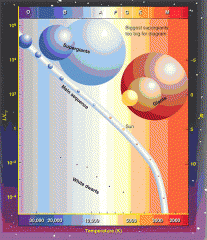
(a) Consider the following terms for the brightness of stars: dwarf, giant, main sequence, supergiant. Rank the terms in order from brightest to dimmest.
(b) Consider the following colors of stars: blue, red, white, yellow. Rank the colors in order from coolest to hottest. |
a) brightest: supergiant, main sequence, dwarf at dimmest
b) coolest: red, yellow, white, blue at hottest |
|
|
(a) What observations are necessary to determine the masses of the stars in a binary system?
(b) How is the answer you chose to the previous question used to determine the masses of the stars? |
a) the orbital period of the system and the distance between the stars
b) With Newton's version of Kepler's third law. |
|
|
The parallax angle of a star and the two lines of sight to the star from Earth form a long skinny triangle with a short side of which of the following?
|
1 AU
|
|

Several stellar spectra are seen here. Which spectral type has the strongest (darkest) hydrogen absorption lines?
|
A
|
|
|
What is the absolute visual magnitude of a star?
|
its apparent magnitude at visible wavelengths at a distance of 10 parsecs
|
|
|
How can a cool star be more luminous than a hot star?
|
It can be more luminous if it is larger.
|
|
|
Of the following sequence of spectral types, which star has the highest surface temperature: A, B, F, K, G?
|
B
|
|
|
Which luminosity class has stars of the lowest density, some even less dense than air at sea level?
|
supergiant
|
|
|
Why are Earth-based parallax measurements limited to the nearest stars?
|
*because our baseline is limited to about 2 AU *because parallax must be measured in front of a farther background
*because the atmosphere distorts/blurs the images of stars, limiting how precisely their position can be measured XXX all of the above (correct answer) |
|
|
(a) TiO bands do not appear in which stars?
(b) What is the reason for your answer to the above question? |
a) high temperature
b) they are broken up by collisions of fast-moving molecules. |
|
|
A particular star with the same spectral type as the sun (G2) has a luminosity of 50 solar luminosities. What does this tell you about the star?
|
It must be larger than the sun.
|
|
|
(a) Rank the following types of stellar spectra in order of increasing temperature: A1, B0, F5, G0, K5, M0. (Use this figure.)
(b) Rank the following spectral lines in order of decreasing wavelength: H-α, He (blue), TiO (green), sodium. |
a) lowest: M0, K5, G0, F5, A1 and B0 at highest
b) highest H-α, sodium, TiO (green) and He (blue) at lowest |
|
|
At what distance must a star be to have its apparent magnitude equal to its absolute magnitude?
|
10 pc
|
|
|
All stars are composed of mostly hydrogen and helium, yet many stars have no lines for hydrogen or helium in their spectrum. What causes this apparent contradiction?
|
The surface temperature is such that the electrons are not at the proper energy levels to produce spectral lines at visible wavelengths.
|
|
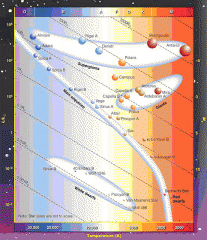
(a) Rank the following stars from the above H-R diagram in order of temperature from coolest to hottest: Arcturus, Deneb, Spica, Sun, Wolf 1346.
(b) Rank the following stars from the above H-R diagram in order of size from largest to smallest: Antares, Barnard's Star, Deneb, Procyon B, Sirius A. (c) Rank the following stars from the above H-R diagram in order of mass from most mass to least mass: Altair, Barnard's Star, Sun, Spica A, Vega. most mass |
a) coolest: Arcturus, Sun , Deneb, Wolf 1346 and Spica at hottest
b) largest: Antares, Deneb, Sirius A, Barnard's Star and Procyon B at smallest c) most mass: Spica A, Vega, Altair, Sun and Barnard's Star at least mass |
|
|
(a) Rank the following colors in order of increasing intensity in a MO type star: blue, red, yellow. (Use this figure.)
(b) Rank the following colors in order of decreasing intensity in an A1 type star: blue, red, yellow. (c) Rank the following spectral lines in order of increasing wavelength: Ca II, H-α, He, sodium. (d) Rank the following types of stellar spectra in decreasing order of their peak wavelengths: A1, G1, M5. (e) Rank the following types of stellar spectra in increasing order of the intensity of their peak wavelengths: F0, K0, M1. |
a) lowest: blue, yellow and red at highest
b) highest: blue, yellow and red at lowest c) lowest: Ca II, sodium, He and H-α at highest d) highest: M5, G1 and A1 at lowest e) lowest: M1, K0 and F0 at highest |
|
|
Double-Line Spectroscopic Binary
(a) The stars in a binary system orbit around what point? (b) For a star approaching an observer, how will its spectrum appear? (c) In what circumstances is the binary stars' spectrum unshifted? |
a) The center of mass
b) blueshifted c) The stars are moving perpendicular to the observer |
|
|
(a) In which type of binary system can astronomers not determine the mass of the stars?
(b) What is the reason for the answer you chose in the previous question? |
a) spectroscopic binaries
b) It is impossible to determine the inclination of a spectroscopic binary system. |
|

The sun's spectral type is G2. What is the sun's luminosity class?
|
main sequence (V)
|
|
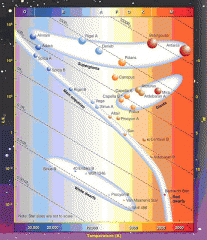
(a) Rank the following stars from the above H-R diagram in order of brightness from dimmest to brightest: Barnard's Star, Canopus, Rigel A, Sirius B, Sun.
(b) Rank the following stars from the above H-R diagram in order of brightness from brightest to dimmest: Aldebaran A, Altair, Antares, Polaris, Procyon B. (c) Rank the following stars from the above H-R diagram in order of temperature from hottest to coolest: Aldebaran A, Altair, Antares, Mira, Rigel A. |
a) dimmest:Barnard's Star, Sirius B, Sun, Canopus
brightest Rigel A b) brightest:Antares, Polaris, Aldebaran A, Altair dimmest Procyon B c) hottest:Rigel A, Altair,Aldebaran A, Mira coolest Antares |
|
|
How does an observatory in orbit help astronomers measure parallax more accurately?
***************END CHAPTER 6******************* |
It is above most of Earth's atmosphere.
***************END CHAPTER 6******************* |
|
|
Why is there a mass-luminosity relation for main sequence stars?
|
The more massive a star is, the higher the rate of fusion in the core is due to the larger weight pressing down on the inner layers. When the energy from the fusion reaction reaches the surface it radiates into space with a characteristic luminosity.
|
|
|
(a) Which is not true about neutrinos?
(b) How do astronomers detect neutrinos? (c) Why are neutrinos so hard to detect? |
a) *They are created during nuclear fusion. *They have very low mass. *They travel very fast.
xxxx All of the above is true about neutrinos. (correct answer) b) They observe nuclear reactions triggered by neutrino collisions in large underground pools of chemicals. c) *They move very fast. *They have very low mass. *They oscillate between three different "flavors." xxx All of the above are reasons. (correct answer) |
|
|
(a) Which is not a difference between the CNO cycle and the proton-proton cycle?
(b) Which is a similarity between the CNO cycle and the proton-proton cycle? |
a)The CNO cycle produces a helium nucleus.
b)They both produce helium nuclei. |
|
|
What force causes the contraction of a cloud of interstellar matter to form a star?
|
gravitational force
|
|
|
Which factor resists the contraction of a cloud of interstellar matter?
|
xxx all of the below
*thermal energy *interstellar magnetic field *rotation *turbulence |
|
|
What eventually halts the slow contraction of a newly forming star?
|
nuclear fusion
|
|
|
Which of the following is NOT considered in making a simple stellar model?
|
magnetic field
|
|
|
(a) Massive, short-lived stars are evidence of which of the following?
(b) Jets of gas emitted from the center of dusty disks are evidence of which of the following? (c) Stars surrounded by short-lived disks of gas and dust are evidence of which of the following? |
a) That star formation is an ongoing process.
b)That protostars really exist. c) none of the above (That star formation is an ongoing process. That protostars really exist. That the Orion region is actively forming stars.) <---- none of those |
|
|
Scattering in Earth's Atmosphere
(a) Why does the Sun appear redder at the horizon? (b) Given that blue light scatters more, what best explains why the Sun appears yellow instead of blue when it's directly overhead? |
a) Because it passes through more atmosphere, and the blue light is scattered more.
b) The Sun radiates much more yellow light than blue light. |
|
|
(a) Where in a star is energy generated?
(b) How does energy get to the surface of a star? (c) How does a star's energy get into space? (d) The most massive stars use----------- to get energy to their surface. (e) The least massive stars use------------ to get energy to their surface. |
a) the core
b) conduction, convection, radiation xxx it could be more than one of the above, depending on the mass of the star (correct answer) c) radiation d) radiation e) convection |
|
|
What prevents the enormous amount of energy released from the fusion reactions at a star's core from blowing the star apart?
|
gravity
|
|
|
Why does fusion require a high temperature?
|
to overcome the repulsive force between the protons
|
|
|
What would happen in the interior of a normal star if gravity were to shrink the star's size a small amount?
|
xxx all of the below
*The interior temperature would increase. *The rate of fusion would increase. * The gas pressure would increase *The interior temperature would increase and the rate of fusion would increase. |
|
|
(a) What are small nebulae that fluctuate in brightness called?
(b) Which is evidence that protostars are surrounded by disks? |
a) Herbig-Haro objects
b) small nebulae that fluctuate in brightness |
|
|
Self-Sustaining Star Formation
(a) Which of the following events can trigger nearby star formation? (b) Spiral galaxy shapes are caused by what phenomenon? (c) Most star formation occurs in what part of a spiral galaxy? |
a) Supernova explosion
b) Differential rotation c) The arms |
|
|
As cold gas in interstellar space contracts, which of the following occurs?
|
*It heats up.
*Its molecules pick up speed. *Gravitational energy is converted to thermal energy. xxx all of the above (correct answer) |
|
|
(a) Where in the sun does nuclear fusion occur?
(b) Why does fusion occur in the layer(s) that it does? |
a) the core
b) Only the core is hot enough. |
|
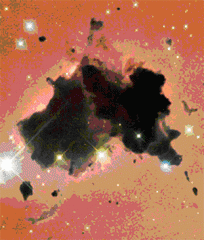
(a) What is the dark area in the above picture?
(b) In the above picture the dark area is doing which of the following? (c) What is the pink area in the above picture? |
a) a dark nebula
b) blocking out light from nearby stars c) emission nebula |
|
|
Where in the sun is the law of hydrostatic equilibrium at work?
|
at every point inside the sun
|
|
|
(a) Which is not true about stars that use the CNO cycle?
(b) Which is true about the cores of stars that use the CNO cycle? (c) Which is true about the outer layers of stars that use the CNO cycle? |
a) They are long-lived.
b) They are small and convective. c) They are radiative only. |
|
|
(a) Which is not true about stars on the lower end of the main sequence?
(b) Which is not true about stars on the lower end of the main sequence? (c) Which is a type of star found on the lower end of the main sequence? (d) Which is a type of star found on the upper end of the main sequence? |
a) They are short-lived.
b) *They are bright and hot. *They are large and of high mass. *They are short-lived. xxx All of the above. (correct answer) c) red dwarf d) O or B |
|
|
(a) At any layer in a star, the weight pressing down is _____ the pressure in the gas.
(b) What is the state described in the previous question called? (c) Which must be true for the state described in the previous questions to be maintained? |
a) equal to
b) hydrostatic equilibrium c) The inner layers of the star must be hotter than the outer layers. |
|
|
(a) What is the main-sequence of the H-R diagram?
(b) Which is not true about stars on the main sequence of the H-R diagram? (c) Which is not a reason that there is a main sequence on the H-R diagram? |
a) *where most of the stars are found *a group of stars ranging from cool and dim to bright and hot *a group of stars ranging from very massive to very low mass
xxx all of the above (correct answer) b) *They are all in hydrostatic equilibrium. *They are all burning hydrogen in the core. *They are all colors of the visible spectrum. xxx All of the above are true. (correct answer) c) not sure of the answer. either: there is a relationship between the brightness and temperature of hydrogen-burning stars. or Stars come in all colors. |
|
|
What solved the solar neutrino problem?
|
The discovery that neutrinos oscillate between three different types.
|
|
|
Reddening and Extinction by Dust
(a) Extinction occurs when: (b) What happens when a star's light is reddened? (c) How will a thin dust cloud affect starlight? |
a) Light from stars is diminished
b) Blue light from the star is scattered by dust c) It will be dimmed and reddened |
|
|
What happens to the neutrinos that are produced in the proton-proton chain?
|
They head out of the sun at nearly the speed of light.
|
|
|
CNO Cycle
(a) The CNO cycle occurs in which types of stars? (b) The 'N' in the CNO cycle represents what element? (c) What type of electromagnetic radiation is emitted during the CNO cycle? |
a) Stars more massive than the sun
b) Nitrogen c) Gamma rays |
|
|
How does the sun maintain its energy output?
|
fusion of hydrogen nuclei
|
|
|
(a) The "thermostat" in a star is a relationship between which of the following?
(b) How does this "thermostat" regulate nuclear fusion in the core? |
a) pressure and temperature
b) *If the star becomes too hot, it will expand until it cools enough to regain equilibrium. *If a star becomes too cool, it will contract until it heats up enough to regain equilibrium. *A change in pressure will be balanced by a corresponding change in temperature. xxx All of the above are true. (correct answer) |
|
|
"Conduction, Convection, and Radiation"
(a) Which process is how Earth receives its energy from the Sun? (b) What heat transfer process is responsible for the granular effect of the Sun's surface? (c) What is the primary heat transfer method of an electric stove? |
a) radiation
b) convection c) conduction |
|
|
At what wavelengths can we observe the early stages of protostar formation?
|
infrared
|
|
|
What happens to the temperature and density inside a collapsing protostar?
|
Temperature and density both increase.
|
|
|
Why does a star's life expectancy depend on mass?
|
More massive stars have shorter lifetimes because their larger masses cause them to consume their fuel faster.
|
|
|
What is a protostar's energy source?
**************END CHAPTER 7****************** |
gravitational energy
**************END CHAPTER 7****************** |
|
|
Nova Mechanism
(a) Novae occur in which of the following star systems? (b) The accretion disk forms around which star in a binary nova system? (c) Why do novae occur? |
a) In binary star systems, when stars are at different stages of evolution
b) The white dwarf c) Matter ignites on the surface of the white dwarf |
|
|
(a) Which is a reason that a neutron star may not be observed from Earth as a pulsar?
(b) What is meant by "Every pulsar is a neutron star, but not every neutron star is a pulsar"? |
a) *Its rotation has slowed to the point where it no longer "pulses." *Its magnetic field is so strong that it does not rotate fast enough to "pulse." *Its radiation is not beamed toward Earth.
xxx All of the above are reasons that a neutron star may not be observed as a pulsar from Earth (correct answer) b) Some neutron stars do not emit "pulses" of radiation for various reasons. |
|
|
How can a black hole emit X-rays?
|
X-rays emitted just before material crosses the event horizon can escape the gravitational pull.
|
|
|
What event marks the end of every star's main-sequence life?
|
the end of hydrogen fusion in the core
|
|
|
(a) Which is not true about a type I supernova?
(b) Which is not true about a type II supernova? |
a) It involves a massive star.
b) It occurs in a binary system. |
|
|
What property does matter inside the event horizon of a black hole retain?
|
mass, angular momentum, and electric charge
|
|
|
What is the lower limit for the mass of neutron stars?
|
about 1.4 solar masses
|
|
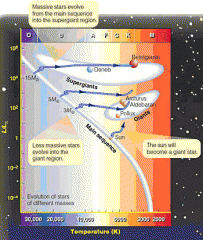
This figure shows the post main-sequence evolution of different stars on the H-R diagram. When the sun leaves the main sequence to become a giant, what happens to its surface temperature and luminosity?
|
The luminosity increases and the surface temperature decreases.
|
|
|
What prevents neutron stars from contracting to a smaller size?
|
degenerate neutrons
|
|
|
Inside Stars
(a) Which element is not created by nuclear fusion in low mass stars? (b) Which element is not created by nuclear fusion in high mass stars? (c) The Sun is about 4.5 billion years old. What reaction is occurring in its core? |
a) Neon
b) Zinc c) Fusing hydrogen into helium |
|
|
What happens to white dwarfs as they age?
|
their surface temperatures decrease and luminosity decreases
|
|
|
How does the main-sequence lifetime of a star compare to its entire fusion lifetime?
|
Stars spend about 90% of their fusion lifetimes on the main sequence.
|
|
|
Consider the following possible stages in the evolution of a star like our sun: giant, main-sequence, planetary nebula, supernova, white dwarf. Rank the stages in the order they occur. Leave out any stages that will not occur in the evolution of a star of similar mass to the sun.
|
first: main-sequence
giant planetary nebula last white dwarf |
|
|
(a) Ultimately a sun-like star will become which of the following?
(b) Why can't the lowest-mass stars have the same fate as the sun-like stars? |
a) white dwarf
b) They are not massive enough to collapse to such a high density. |
|
|
How much longer will the sun last?
|
about 5 billion years
|
|
|
Which type of supernova leaves NO core remnant?
|
supernova type Ia
|
|
|
End States of Stars
(a) High mass stars live longer than low mass stars. (b) The more massive the star, the more dense its end state. (c) Low mass stars explode as supernovae. |
a) False
b) True c) False |
|
|
What is one of the reasons astronomers don't use visible-wavelength telescopes to locate neutron stars?
|
Neutron stars are very small.
|
|
|
(a) If the sun were replaced by a 1 solar-mass black hole, how would Earth's orbit change?
(b) What would the radius of the sun be in this case? |
a) Earth's orbit would not change.
b) 3 km |
|
|
How are the ages of star clusters related to their turnoff points?
|
The age of a cluster is the life expectancy of stars at its turnoff point and the lower the turnoff point, the older the star cluster.
|
|
|
Roche Lobes
(a) Where is the center of mass in the binary system illustrated? (b) What happens when a star expands to fill its Roche lobe? (c) The Roche lobes of a binary system meet at what point? |
a) Within the Roche lobe of the larger star
b) Matter from the star overflows forming an accretion disk around its companion c) At the lagrange point between the two stars |
|
|
What prevents gravity from shrinking a white dwarf to a smaller size?
|
degenerate electrons
|
|
|
Why does an expanding giant star become cooler?
|
Energy is absorbed in expanding and lifting the gas.
|
|
|
a) Why are neutron stars expected to be hot?
(b) Why are neutron stars expected to spin fast? (c) Why are neutron stars expected to have strong magnetic fields? |
a) They are so compact.
b) They are so compact. c) They are so compact. |
|
|
Consider the following objects: blackhole, neutron star, white dwarf.
(a) Rank the objects in order of increasing mass. (b) Rank the objects in order of increasing size. (c) Rank the objects in order of decreasing density. (d) Rank the objects in order of increasing rotation rate. |
a) least:white dwarf
neutron star greatest: black hole b) least:black hole neutron star greatest: white dwarf c) greatest:black hole neutron star least: white dwarf d) least:white dwarf neutron star greatest: black hole |
|
|
(a) What is required for carbon fusion to occur in the core of a star?
(b) Why is it that can some stars cannot fuse carbon or heavier elements? |
a) *high mass *high temperature *high pressure
xxx all of the above (correct answer) b) If they are not massive enough, there is not enough pressure on the core to achieve the necessary temperatures. |
|
|
(a) What is the approximate upper limit of the mass of a neutron star?
(b) Why is the upper limit only approximate? |
a) 3 solar masses
b) The exact strength of pure neutron material is not actually known. |
|
|
Consider the following objects: soft gamma ray repeaters, hypernovae, x-ray bursts.
(a) List the events in order of increasing energy. (b) List the events in order of increasing rarity. |
a) least:x-ray bursts
soft gamma ray repeaters greatest: hypernovae b) least: x-ray bursts soft gamma ray repeaters greatest: hypernovae |
|
|
What observational evidence do we have that stellar-death black holes really exist?
|
Some X-ray binaries have unseen objects with masses greater than 3 solar masses.
|
|
|
Why do the millisecond pulsars spin so fast?
|
Accretion of matter from a nearby binary companion spins them up.
|
|
|
White dwarfs and neutron stars are both end products of stellar evolution. White dwarfs are composed of mostly carbon, oxygen, and electrons, whereas neutron stars are composed of mostly neutrons. What happens to the protons in the atomic nuclei and the degenerate electrons that were inside the star that creates a neutron star?
|
The electrons and protons combine to form neutrons and neutrinos.
|
|
|
(a) Which is true for X-ray bursters?
(b) How do X-ray bursters resemble a nova? |
a) *They appear in binary systems. *They are caused by mass transfer to neutron stars.*They occur when helium fusion ignites. xxx all of the above (correct answer)
b) *They are both caused by mass-transfer. *They are both caused by the ignition of fusion.*They are both a surface explosion. xxx all of the above (correct answer) |
|
|
Which of the following is an accurate description of the Schwarzschild radius?
|
It is the radius to which an object must shrink to become a black hole and is the radius of the event horizon surrounding a black hole singularity.
|
|
|
What changes would occur if the sun were replaced with a one-solar-mass black hole?
|
Earth's orbit would not change and the planets would disappear from view.
|
|
|
(a) Which is true for the H-R diagram of a star cluster that has many hot, blue, luminous stars?
(b) If a star cluster has many hot, blue, luminous stars which of the following is probably correct? (c) What is the reason for the answers to the previous questions? |
a) It will have stars over most of the main sequence.
b) It is young. c)Hot, blue, luminous stars do not live long lives |
|
|
(a) What is the Schwarzschild radius?
(b) If the sun has a Schwarzschild radius, why isn't it a black hole? (c) What is the Schwarzschild radius of an object? |
a) *It is the radius of the event horizon of a black hole. *It is the size of an object when it becomes a black hole.* It is dependent of the mass of an object. xxx all of the above (correct answer)
b) It is not massive enough. c) It can be any size, depending on the mass of an object. |
|
|
Which of the following statements accurately describe(s) some observed properties of supernovae type Ia and supernovae type II?
|
Supernovae type II have hydrogen lines in their spectra and supernovae type Ia are more luminous.
|
|
|
Neutron Star
(a) All pulsars are believed to be neutron stars, but not all neutron stars are pulsars. (b) The "pulse" from both jets will be most clearly seen when the magnetic and spin axes: |
a) True
b) Align at a 90 degree angle and the spin axis is perpendicular to our line of sight. |
|
|
Post Main-Sequence Evolution
(a) A star moves off the ZAMS after burning up what element? (b) When a star becomes a red giant, its surface temperature (c) How does a star that is burning helium differ from one burning hydrogen? |
a) Hydrogen
b) decreases. c) It gets brighter |
|
|
Consider the following shells of gas in the core of a massive star: carbon, helium, hydrogen, iron, neon, oxygen, silicon.
(a) List these in the order that the shells would be found, starting with the inner-most. (b) Rank the same gases in the order in which they would appear at the innermost core of a massive star as it evolves. |
a) inner-most: iron
silicon oxygen neon carbon helium outer-most: hydrogen b) first: hydrogen helium carbon neon oxygen silicon last: iron |
|

Suppose that you monitor the apparent brightness of a supernova and notice that 50 days after it reached maximum brightness, it has dimmed by 2 magnitudes. Examine the light curves in this figure. Which type of supernova are you most likely observing?
|
Type II
|
|
|
(a) How can you estimate the age of a star cluster?
(b) What is the turnoff point of a star cluster? |
a) by its brightest stars
b) the location on the H-R diagram where stars are leaving the main sequence |
|
|
Cluster Turnoff
(a) The stars in a cluster move off the main sequence: (b) A cluster whose stars fill the entire s-curve of the main sequence: (c) As the animation shows, as stars age and move off the main sequence, they initially become: |
a) At an ever slower pace.
b) Must be young. c) More luminous and cooler |
|
|
Why do we expect that neutron stars spin rapidly?
|
the law of conservation of angular momentum
|
|
|
Why do supernova remnants emit x-rays?
|
because they are filled with hot gas
|
|
|
Why can't massive stars generate energy from iron fusion?
|
Not sure: either Not enough iron is present. or Iron fusion consumes energy.
|
|
|
(a) Which is true for the event horizon of a black hole?
(b) What evidence is there that black holes have event horizons? **********END CHAPTER 8******************** |
a) *It will not allow light to travel from inside of it to the outside. *It surrounds the singularity. *It has a radius equal to the Schwarzschild radius. xxx all of the above (correct answer)
b) *Binary systems where mass transfer results in mass "fading out" rather than exploding as a nova. *Matter actually vanishing from accretion disks. xxx both of the above (correct answer) **********END CHAPTER 8******************** |
|
|
(a) At which wavelengths are stars around Sgr A* observed?
(b) What is the reason for the answer to the previous question? |
a) infrared
b) There so many stars that they warm the dust. |
|
|
What do astronomers believe is responsible for the somewhat flocculent, somewhat grand design spiral arms of the Milky Way Galaxy?
|
xxx all of the below (correct answer)
*spiral density waves*self-sustaining star formation *differential rotation *spiral density waves and self-sustaining star formation |
|
|
(a) Why is it difficult to determine the size of the galactic disk?
(b) Why is it difficult to determine the size of the galactic halo? |
a) *because we are on the inside looking out *because of interstellar dust xxx both of the above are reasons (correct answer)
b) because we are on the inside looking out |
|
|
What does the observed heavy element abundance tell us about a star?
|
A low percentage of metals indicates that a star formed long ago.
|
|
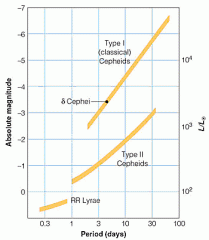
This graph shows the period-luminosity relation for Cepheid variables. If the period of a type I Cepheid is 10 days, what is its absolute magnitude?
|
-4.3
|
|
|
With the 100 inch telescope, Harlow Shapley could not resolve variable stars in the more distant globular clusters of the Milky Way. What basic assumption did Shapley make about the far-away globular clusters that allowed their distances to be found?
|
Far-away globular clusters have the same average size as nearby globular clusters.
|
|
|
How are population II stars different than the sun, a population I star?
|
Population II stars are lower in metals than population I stars.
|
|
|
What did the Herschels find when they counted stars in 683 regions around the Milky Way?
|
About the same number of stars in each direction.
|
|

(a) Why does the galaxy in the figure below have so much dust in the disk?
(b) How big do you suppose the halo of the galaxy in the figure really is? |
a) The disk is where we would expect to find dust.
b) much larger than what we see |
|
|
Which is observational evidence that the center of the galaxy contains a supermassive black hole?
|
*x-ray emissions *high orbital speeds of stars *very large mass xxx all of the above (correct answer)
|
|
|
Which of the following are good visible-light spiral arm tracers?
|
O and B associations and HII regions
|
|
|
What main conclusion did Shapley draw from his measurements of the distances to the globular clusters?
|
The sun is far from the center of the Milky Way.
|
|
|
(a) Where in the galaxy are "high-velocity" stars found?
(b) Why are "high-velocity" stars named so? (c) How do the metal abundances of high-velocity stars compare to those of the sun? (d) What is the reason for the answer to the previous question? |
a) in the halo
b) When they cut through the orbits of stars in the disk, they appear to have very high velocities c) They are lower. d) They formed before the sun. |
|
|
What is the approximate diameter of the disk component of the Milky Way Galaxy?
|
80,000 ly
|
|
|
Where are the youngest stars in the Milky Way Galaxy located?
|
in the flattened disk
|
|
|
Which is not explained by the traditional theory of the formation of our galaxy?
|
Some of the stars in the central bulge are very old.
|
|
|
Which of the following are problems facing the traditional hypothesis of the formation of the Milky Way?
all of the below Not all globular clusters have the same age. Some of the oldest stars are in the central bulge. The oldest stars are not completely metal-free. The disk seems much younger than the globular clusters. |
xxx all of the below (correct answer) *Not all globular clusters have the same age. *Some of the oldest stars are in the central bulge. *The oldest stars are not completely metal-free. *The disk seems much younger than the globular clusters.
|
|
|
At what wavelength band can we observe the center of our galaxy?
|
radio, infrared, X ray
|
|
|
What measurements are needed to determine the entire mass of the Milky Way Galaxy?
|
the rotational velocity of a star near the Galaxy's outer edge and the distance to a star near the Galaxy's outer edge
|
|
|
(a) What are spiral tracers?
(b) Which is not an example of a spiral tracer? (c) What is true about the age of most spiral tracers? (d) What is the reason for the answer to the previous question? |
a)objects used to map spiral arms
b) *O and B associations *young open clusters *high-mass variable stars xxx all of the above are spiral tracers (correct answer) c) They are young. d) Spiral arms are places of star formation. |
|
|
How are star clusters distributed in the sky?
|
Open clusters lie along the Milky Way and half of the globular clusters are in or near the constellation Sagittarius.
|
|
|
(a) How does the orbital velocity of stars around the center of the galaxy vary with distance from the center? (more than one answer may be correct)
(b) What does the behavior of stars from question (a) above suggest about the mass of our galaxy? (c) What do the answers to the previous two questions suggest about our galaxy? (d) As a result of all this, what have astronomers theorized about the structure of our galaxy? |
a) stars closer to the center actually go slower and relatively constant at distances farther from the center
b) That it is more massive than we would expect from the observed stars. c) that there is much more mass than is observed d) That there is a galactic corona made largely of dark matter. |
|
|
What must be measured to determine distance by the Cepheid variable star method?
|
the apparent magnitude and the period of pulsation of the variable star
|
|
|
(a) The abundance of metal in older stars is ______ in younger stars.
(b) What is the reason for the answer to the previous question? |
a) less than
b) There were no heavy elements available when the older stars were forming. |
|
|
(a) Stars in the disk of the galaxy tend to have more------ orbits than those in the halo.
(b) Stars in the halo of the galaxy tend to have more-------- orbits than those in the disk. |
a) circular
b) elliptical |
|
|
What do we observe at radio, infrared, and X-ray wavelengths near the center of the Milky Way Galaxy that leads us to conclude that a supermassive black hole is located there?
|
xxx all of the below (correct answer)
*a strong source of radio waves called Sagittarius A* *a rapid rate of star formation *supernova remnants *a rapid rate of star formation and supernova remnants |
|
|
What main conclusion did the Herschels draw from their star counts?
|
The Milky Way is a disk of stars with the sun near the center.
|
|
|
(a) At which wavelength is the center of the galaxy not observed?
(b) Which is not observed at the galactic center? |
a) visible
b) *complex structures caused by magnetic fields *crowded stars *warmed dust xxx all of the above are observed (correct answer) |
|
|
(a) Why do some clusters lose stars more slowly than others?
(b) Which type of cluster is more likely to have stars "wander away"? How is the rate of star loss affected by the age of a cluster? (d) What is the reason for the answer to the previous question? |
a) *different ages *different masses of stars in clusters *different amounts of gravity holding the clusters together
xxx all of the above (correct answer) b) an open cluster c) Younger clusters lose stars faster. d) More massive stars will burn out early in the cluster's life. |
|
|
Who discovered that when viewed through a telescope, the Milky Way is resolved into thousands of individual stars?
|
Galileo Galilei
|
|
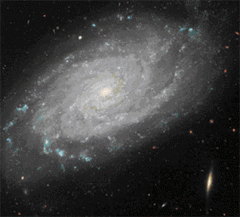
(a) Why are the spiral arms in the galaxy in the figure below blue?
(b) What color would the halo of the galaxy in the figure be if it were bright enough to be seen? |
a) Spiral arms are made mostly of young stars.
b) white |
|
|
Which single wavelength band is best for mapping out the spiral arm structure of the Milky Way Galaxy?
|
radio
|
|

Which of these two figures illustrates the orbits of population II stars?
|
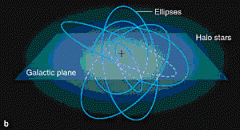
figure b
|
|
|
(a) Which is not true about spiral arms?
(b) What is the reason for the answer to the previous question? |
a) They are physically connected structures.
b) *Differential rotation would destroy them. *Rotation of the galaxy does not allow dynamic stability. *They are very old structures. xxx All of the above are reasons. (correct answer) |
|
|
(a) Which is not an example of a trigger for self-sustaining star formation?
(b) Why does self-sustaining star formation often result in clouds of stars similar to a segment of a spiral arm? |
a) spiral density waves
b) Differential rotation drags the inner edge of the cloud ahead of the outer edge. |
|
|
What fundamental principle did Shapley use to calibrate the period-luminosity relationship for Cepheid variable stars?
|
Objects with large proper motion tend to be closer than objects with small proper motion.
|
|
|
(a) Why didn't astronomers realize at first how large the galaxy is?
(b) Who was the first astronomer to get a reasonable idea of the size and shape of the galaxy? Kapteyn ****************END CHAPTER NINE************ |
a) interstellar dust obscuring starlight
b) Shapley ****************END CHAPTER NINE************ |
|
|
How are the spectra of Seyfert galaxies different from most galaxies?
|
They have broad emission lines of highly ionized elements.
|
|
|
Where are all the dead quasars?
|
They lurk quietly at the hearts of galaxies.
|
|
|
(a) What is "look-back time?"
(b) Why is look-back time not important for nearby galaxies? |
a) *how long the light from an object takes to reach us *the same as the distance in light-years to an object xxx both of the above (correct answer)
b) Galaxies change very slowly. |
|
|
What observational evidence leads us to believe that AGNs contain supermassive black holes?
|
The gas in the disk is orbiting at high speeds and short-duration fluctuations in brightness limit the size of the object at the center of an AGN.
|
|
|
(a) Which is not calculated from direct observation used in determining the mass of a galaxy by the rotation curve method?
(b) How is determining the mass of a galaxy by the rotation curve method similar to determining the masses of stars in binary systems? |
a) doppler shifts
b) *the use of Doppler shifts *the use of Kepler's 3rd law xxx both of the above (correct answer) |
|
|
What assumption is made in determining mass by the rotation curve method, the cluster method, and the velocity dispersion method?
|
Newton's law of gravity is valid and that the system being measured is holding itself together
|
|
|
What observable property of a standard candle must be measured to determine its distance?
|
apparent magnitude
|
|

The apparent recessional speeds of four galaxies are shown on this image. What do these apparent recessional speeds suggest?
|
All four galaxies are about the same distance away from us.
|
|
|
When viewing a distant galaxy, the amount of look-back time in years is equal to which of the following?
|
distance to the galaxy in light years
|
|
|
What must we know about an object to use it as a distance indicator?
|
either the object's luminosity or the object's linear size
|
|
|
Quasars have which of the following characteristics?
|
Quasars have bright emission-line spectra.
|
|
|
Seyfert galaxies have a spectrum with broad emission lines of ionized elements. What other unusual features do Seyfert galaxies have?
|
They have small, highly luminous nuclei that fluctuate rapidly.
|
|
|
(a) Rank the subclasses of spiral galaxies in order of how tightly wound they are: Sa, Sb, Sc.
(b) Rank the subclasses of spiral galaxies in order of the size of their nuclei, from smallest to largest: Sa, Sb, Sc. smallest Sc |
a) most:Sa
Sb least: Sc b) smallest: Sc Sb largest: Sa |
|
|
Why are most quasars so far away?
|
There is a greater volume of the universe that is far away than is nearby and quasars were more abundant in the past when galaxies were close together.
|
|
|
What is at the center of Seyfert galaxies?
|
supermassive black holes
|
|
|
Which of the following is the least important factor in galactic evolution?
|
the elemental composition of the material from which galaxies form
|
|
|
What fraction of spiral galaxies are Seyfert galaxies?
|
about 2%
|
|
|
Galaxies in close pairs are three times more likely to be Seyfert galaxies than are isolated galaxies. What general conclusion can be drawn from this statistical fact?
|
Seyfert galaxies are very likely the result of galaxy interactions.
|
|
|
(a) What is the Milky Way in our sky?
(b) Would people living on a planet orbiting a star in an E0 type galaxy see a Milky Way? |
a) *It is bright band of light that goes around the entire sky. *It is the disk of the galaxy of which we are a part. xxx both of the above (correct answer)
b) No, their galaxy has no disk. |
|
|
What parameter must we know to determine the linear diameter and luminosity of a particular galaxy?
|
the distance to the galaxy
|
|
|
Which of the following is NOT a distance indicator used in galactic astronomy?
|
white dwarfs
|
|
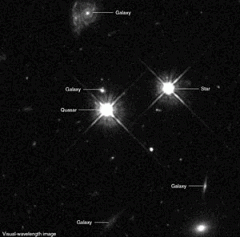
The name "quasar" is derived from the description "quasi-stellar radio source." In this image the quasar (center) appears star-like. How are quasars very different from stars?
|
xxx all of the below (correct answer)
*Quasars have highly redshifted spectral lines. *Quasars have emission line spectra. *No quasars are nearby. *Quasars have highly redshifted spectral lines and emission line spectra. |
|
|
What conditions can create broad emission lines of highly ionized elements?
|
xxx all of the below
*High-temperature gas must be present. *Low-density gas must be present. *The gas must be rotating at high speeds. *High-temperature and low-density gas must be present. |
|
|
What does it mean that quasars are most common at a redshift of about 2?
|
Quasars were more plentiful in the past.
|
|
|
In the figure below, visible wavelengths are in blue and radio wavelengths are in red.
(a) What are the red images? (b) What are the blue images? |
a) radio lobes
b) radio lobes |
|
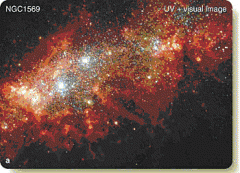
This is an image of the starburst galaxy NGC 1569. What is believed to be the cause of the recent rapid rate of star formation in this galaxy?
|
NGC 1569 has recently collided with another galaxy.
|
|
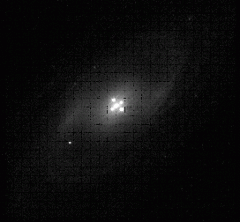
This image shows four quasars around a galaxy. The redshift of each of the four quasars is 0.0394 and greater than that of the galaxy. How should we interpret this photo?
|
The galaxy acts as a gravitational lens and the four quasar images are of the same quasar.
|
|
|
(a) Rank the subclasses of elliptical galaxies in order of how elliptical they are: E1, E3, E5, E7.
(b) Rank the galactic types in order of how "ordered" of a structure they have, with the most ordered first: elliptical, irregular, spiral. |
a) least:E1
E3 E5 greatest: E7 b) most: elliptical spiral least: irregular |
|
|
Which feature of a galaxy seems to be related to the mass of the galaxy's central supermassive black hole?
|
the size of the galaxy's central bulge
|
|
|
Which type of galaxy has the largest range in both size and mass?
|
elliptical
|
|
|
Why is a supernova type Ia standard candle better to use in measuring very long distances than either the brightest globular cluster or Cepheid Variable star standard candles?
|
Supernovae type Ia are more luminous.
|
|
|
(a) What is the Hubble Law a relationship between?
(b) What must actually be measured to use the Hubble law to determine the distance to a galaxy? (c) What must be known to estimate the distance to a galaxy with the Hubble law? |
a) the distance and recessional velocity of a galaxy
b) a galaxy's redshift c) *the Hubble constant *the recessional velocity xxx both of the above (correct answer) |
|
|
Which of the following is true about supermassive black holes?
|
They represent about 0.5 percent of the mass of the nuclear bulge and there is no relationship between the mass of the supermassive black holes and the mass of the disks of galaxies.
|
|

What does the flatness of the rotation curve shown here reveal about this galaxy?
|
It has a lot of nonluminous (dark) matter in its outer regions.
|
|
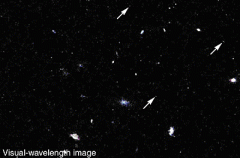
Why are the three very distant galaxies pointed out in this image (see white arrows) red in color?
|
The extreme recessional speed causes a large Doppler shift.
|
|
|
(a) Which is a more likely evolution of galaxies?
(b) What is the most likely way that one type of galaxy may be formed from others? (c) What type of galaxy is the most likely result of the process of the previous question? |
a) neither is very likely (spiral to elliptical, elliptical to spiral)
b) mergers c) elliptical |
|

What does the degree of gravitational lensing seen in this image indicate?
|
Galaxy clusters contain much more mass than is visible
|
|
|
Cosmic Redshift
(a) Approximately what would you expect the velocity of a galaxy cluster at 1000 Mpc to be? (b) If a galaxy cluster's velocity is observed at 850 km/s, how far away is it? (c) What does this interactive suggest is the correct value for the Hubble Constant? |
a) 70,000 km/s
b) 12 Mpc c) A value of approximately 70 to 71 km/s/Mpc with some degree of uncertainty. |
|
|
Galaxies with active star formation also have which of the following?
|
xxx all of the below (correct answer)
*plenty of gas and dust *O and B associations*emission nebula *a bluish tint |
|
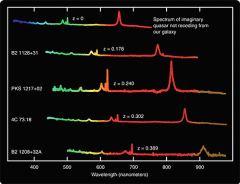
(a) Rank the 4 quasars in the figure below in order of their likely distance from us (from closest to farthest).
(b) Rank the quasars in order of their amount of redshift (from smallest to largest). |
a) closest:B2 1128+31
PKS 1217+02 4C 73.18 farthest: B2 1206+32A b) smallest:B2 1128+31 PKS 1217+02 4C 73.18 largest: B2 1206+32A |
|
|
What evidence do we have that quasars are very far away?
|
xxx all of the below (correct answer)
*Their spectral lines have large redshifts. *Some are gravitationally lensed by distant galaxies. *Some light from quasars contains less redshifted absorption lines of distant galaxies. *Some quasars have nearby galaxies with similar redshifts in their spectra. |
|
|
Which is evidence that quasars are very far away?
|
*large redshifts *gravitational lensing *we know they are superluminous, so since they look dim, they must be far away
xxx all of the above are evidence (correct answer) |
|
|
Galaxy Types
(a) Which two types of galaxies are most closely related? (b) Which of these is evidence of star formation in a distant galaxy? (c) We cannot see differences in the spectra of other galaxies because they are too far away. |
a) Spirals and barred galaxies
b) Areas that appear blue c) False |
|
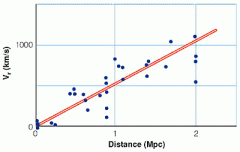
If you take the slope of this 1929 graph by Edwin Hubble, you get an expansion rate (Hubble constant) much greater than today's value of 70 km/s/Mpc. What is responsible for this difference?
|
Edwin Hubble's 1929 distances were far too small.
|
|
|
How are the shapes of galaxies affected by collisions?
|
They are twisted and distorted by tidal forces
|
|
|
What evidence do we have that quasars are small?
|
They have rapid fluctuations in brightness.
|
|
|
What evidence is there that galactic cannibalism really happens?
*************END CHAPTER TEN****************** |
Some galaxies appear to have multiple nuclei.
*************END CHAPTER TEN***************** |

